Simulating the Coastal Protection Performance of Breakwaters in the Mekong Delta: Insights from the Western Coast of Ca Mau Province, Vietnam
Abstract
1. Introduction
- Quantify and compare the wave attenuation capacity of different fixed and floating breakwater structures;
- Analyze shoreline change and mangrove recovery dynamics over two decades, before and after breakwater installation;
- Simulate the wave–structure–mangrove interactions under varying forest widths and coastal configurations;
- Provide recommendations for adaptive, scalable coastal defense strategies in sediment-starved delta environments.
2. Study Area
3. Materials and Methods
3.1. Wave Conditions and Shoreline Change Assessment
3.1.1. Wave Measurement
3.1.2. Deposition/Erosion Measurement
3.1.3. Image Processing and Mangrove Area Dynamics
- Data Sources
- b.
- Image Processing
3.2. Hydraulic Model Simulation—Flow3D
3.2.1. Input Data
3.2.2. Model Setting-Up
- -
- A flat seabed topography;
- -
- A water column depth of 10 m;
- -
- Simulated waves are wind-generated waves following the Jonswap spectrum.
- Defining the Physical Parameters of the Model
- b.
- Mesh Creation
3.2.3. Wave Height Reduction Evaluation
4. Results
4.1. Current Status of Different Measures
4.1.1. Wave Height Recorded
4.1.2. Deposition/Erosion Status
4.1.3. Mangrove Area
4.2. Results of Hydraulic Model Simulation
4.2.1. Wave Reduction Effectiveness of Mangroves
4.2.2. Wave Reduction Effectiveness of Various Types of Pilot Breakwaters
- -
- Busadco breakwater (Figure 14a): This structure shows relatively high water level fluctuation in front of the breakwater, with a noticeable reduction behind it. The wave attenuation is evident, indicating its effectiveness in dissipating wave energy.
- -
- Semi-circular breakwater (Figure 14b): Similar to the Busadco design, the semi-circular breakwater also reduces the amplitude of water level fluctuations behind the structure. However, the attenuation appears slightly less pronounced compared to the Busadco breakwater.
- -
- Pile-rock breakwater (Figure 14c): The water level fluctuations in front of the pile-rock structure show a comparable amplitude to those observed in the Busadco case, but the reduction behind the structure is moderate due to the permeable nature of the pile-rock configuration.
- -
- Floating breakwater (Figure 14d): Among the four types, the floating breakwater exhibits the lowest difference between the in-front and behind measurements. This indicates that while it reduces wave energy to some extent, its performance is less effective compared to the solid breakwaters.
5. Discussion
5.1. Comparative Performance of Breakwater Types
5.2. Shoreline Dynamics and Mangrove Recovery
5.3. Implications for Hybrid and Adaptive Solutions
5.4. Socio-Economic and Policy Considerations
5.5. Limitations and Future Directions
6. Conclusions
Author Contributions
Funding
Data Availability Statement
Acknowledgments
Conflicts of Interest
References
- Syvitski, J.P.; Vörösmarty, C.J.; Kettner, A.J.; Green, P. Impact of humans on the flux of terrestrial sediment to the global coastal ocean. Science 2005, 308, 376–380. [Google Scholar] [CrossRef] [PubMed]
- Allison, M.; Yuill, B.; Törnqvist, T.; Amelung, F.; Dixon, T.; Erkens, G.; Stuurman, R.; Jones, C.; Milne, G.; Steckler, M. Global risks and research priorities for coastal subsidence. Eos 2016, 97, 22–27. [Google Scholar] [CrossRef]
- Tessler, Z.D.; Vörösmarty, C.J.; Grossberg, M.; Gladkova, I.; Aizenman, H.; Syvitski, J.P.; Foufoula-Georgiou, E. Profiling risk and sustainability in coastal deltas of the world. Science 2015, 349, 638–643. [Google Scholar] [CrossRef]
- Walton, R.E.; Moorhouse, H.L.; Roberts, L.R.; Salgado, J.; Ladd, C.J.; Do, N.T.; Panizzo, V.N.; Van, P.D.T.; Downes, N.K.; Trinh, D.A. Using lake sediments to assess the long-term impacts of anthropogenic activity in tropical river deltas. Anthr. Rev. 2024, 11, 442–462. [Google Scholar] [CrossRef]
- Temmerman, S.; Kirwan, M.L. Building land with a rising sea. Science 2015, 349, 588–589. [Google Scholar] [CrossRef]
- Tri, V.P.D.; Yarina, L.; Nguyen, H.Q.; Downes, N.K. Progress toward resilient and sustainable water management in the Vietnamese Mekong Delta. Wiley Interdiscip. Rev. Water 2023, 10, e1670. [Google Scholar] [CrossRef]
- Biggs, D.; Miller, F.; Hoanh, C.T.; Molle, F. The delta machine: Water management in the Vietnamese Mekong Delta in historical and contemporary perspectives. In Contested Waterscapes in the Mekong Region; Routledge: Oxfordshire, UK, 2012; pp. 203–225. [Google Scholar]
- Park, E. Sand mining in the Mekong Delta: Extent and compounded impacts. Sci. Total Environ. 2024, 924, 171620. [Google Scholar] [CrossRef]
- Anthony, E.J.; Brunier, G.; Besset, M.; Goichot, M.; Dussouillez, P.; Nguyen, V.L. Linking rapid erosion of the Mekong River delta to human activities. Sci. Rep. 2015, 5, 14745. [Google Scholar] [CrossRef]
- Tran, D.Q.; Le, K.N.; Durand-Morat, A.; Nguyen, N.N.; Bairagi, S.K.; Huynh, M.V.; Tran, T.V. Is it worth it? Land-fallowing and saltwater intrusion control under uncertainty. Sci. Total Environ. 2025, 966, 178711. [Google Scholar] [CrossRef] [PubMed]
- Pontee, N.; Narayan, S.; Beck, M.W.; Hosking, A.H. Nature-based solutions: Lessons from around the world. Marit. Eng. 2016, 169, 29–36. [Google Scholar]
- Temmerman, S.; Meire, P.; Bouma, T.J.; Herman, P.M.; Ysebaert, T.; De Vriend, H.J. Ecosystem-based coastal defence in the face of global change. Nature 2013, 504, 79–83. [Google Scholar] [CrossRef] [PubMed]
- Masselink, G.; Scott, T.; Poate, T.; Russell, P.; Davidson, M.; Conley, D. The extreme 2013/2014 winter storms: Hydrodynamic forcing and coastal response along the southwest coast of England. Earth Surf. Process. Landf. 2016, 41, 378–391. [Google Scholar] [CrossRef]
- Sutton-Grier, A.E.; Wowk, K.; Bamford, H. Future of our coasts: The potential for natural and hybrid infrastructure to enhance the resilience of our coastal communities, economies and ecosystems. Environ. Sci. Policy 2015, 51, 137–148. [Google Scholar] [CrossRef]
- Zoccarato, C.; Minderhoud, P.S.; Teatini, P. The role of sedimentation and natural compaction in a prograding delta: Insights from the mega Mekong delta, Vietnam. Sci. Rep. 2018, 8, 11437. [Google Scholar] [CrossRef] [PubMed]
- Jordan, C.; Visscher, J.; Viet Dung, N.; Apel, H.; Schlurmann, T. Impacts of human activity and global changes on future morphodynamics within the Tien river, Vietnamese Mekong delta. Water 2020, 12, 2204. [Google Scholar] [CrossRef]
- Tiede, J.; Jordan, C.; Lojek, O.; Visscher, J.; Schlurmann, T. Hydro- and Morphodynamic Regime of the Tien River, Mekong Delta. In Coastal Structures 2019; Goseberg, N., Schlurmann, T., Eds.; Bundesanstalt für Wasserbau. S.: Karlsruhe, ND, USA, 2019; pp. 426–434. [Google Scholar] [CrossRef]
- Lavane, K.; Kumar, P.; Meraj, G.; Han, T.G.; Ngan, L.H.B.; Lien, B.T.B.; Van Ty, T.; Thanh, N.T.; Downes, N.K.; Nam, N.D.G. Assessing the effects of drought on rice yields in the Mekong Delta. Climate 2023, 11, 13. [Google Scholar] [CrossRef]
- Dang, A.T.; Reid, M.; Kumar, L. Coastal Melaleuca wetlands under future climate and sea-level rise scenarios in the Mekong Delta, Vietnam: Vulnerability and conservation. Reg. Environ. Change 2023, 23, 21. [Google Scholar] [CrossRef]
- Ty, T.V.; Lavane, K.; Nguyen, P.C.; Downes, N.K.; Nam, N.D.G.; Minh, H.V.T.; Kumar, P. Assessment of relationship between climate change, drought, and land use and land cover changes in a semi-Mountainous area of the Vietnamese Mekong delta. Land 2022, 11, 2175. [Google Scholar] [CrossRef]
- Minh, H.V.T.; Nam, N.D.G.; Ngan, N.V.C.; Van Thinh, L.; Nam, T.S.; Van Cong, N.; Nhat, G.M.; Lien, B.T.B.; Kumar, P.; Downes, N.K. Is Vietnam’s Mekong Delta Facing Wet Season Droughts? Earth Syst. Environ. 2024, 8, 963–995. [Google Scholar] [CrossRef]
- Hensengerth, O.; Lam, T.H.O.; Tri, V.P.D.; Hutton, C.; Darby, S. How to promote sustainability? The challenge of strategic spatial planning in the Vietnamese Mekong Delta. J. Environ. Policy Plan. 2024, 26, 91–103. [Google Scholar] [CrossRef]
- Ty, T.V.; Duy, D.V.; Phat, L.T.; Minh, H.V.T.; Thanh, N.T.; Uyen, N.T.N.; Downes, N.K. Coastal erosion dynamics and protective measures in the Vietnamese Mekong Delta. J. Mar. Sci. Eng. 2024, 12, 1094. [Google Scholar] [CrossRef]
- Tran, T.; Pham, D.; Tran, V.T. Shoreline evolution in adjacent to a coastal structure in Hiep Thanh commune, Duyen Hai district, Tra Vinh province. CTU J. Innov. Sustain. Dev. 2024, 16, 8–13. [Google Scholar] [CrossRef]
- Tinh, P.H.; MacKenzie, R.A.; Hung, T.D.; Vinh, T.V.; Ha, H.T.; Lam, M.H.; Hanh, N.T.H.; Tung, N.X.; Hai, P.M.; Huyen, B.T. Mangrove restoration in Vietnamese Mekong Delta during 2015–2020: Achievements and challenges. Front. Mar. Sci. 2022, 9, 1043943. [Google Scholar] [CrossRef]
- Albers, T.; Dinh, S.; Schmitt, K. Shoreline Management Guidelines: Coastal Protection in the Lower Mekong Delta; Deutsche Gesellschaft für Internationale Zusammenarbeit (GIZ) GmbH: Bonn/Eschborn, Germany, 2013; Volume 1, pp. 1–124. [Google Scholar]
- Le Xuan, T.; Ba, H.T.; Thanh, V.Q.; Wright, D.P.; Tanim, A.H.; Anh, D.T. Evaluation of coastal protection strategies and proposing multiple lines of defense under climate change in the Mekong Delta for sustainable shoreline protection. Ocean Coast. Manag. 2022, 228, 106301. [Google Scholar] [CrossRef]
- Veettil, B.K.; Ward, R.D.; Dung, N.T.K.; Van, D.D.; Quang, N.X.; Hoai, P.N.; Hoang, N.-D. The use of bioshields for coastal protection in Vietnam: Current status and potential. Reg. Stud. Mar. Sci. 2021, 47, 101945. [Google Scholar] [CrossRef]
- Albers, T.; Schmitt, K. Dyke design, floodplain restoration and mangrove co-management as parts of an area coastal protection strategy for the mud coasts of the Mekong Delta, Vietnam. Wetl. Ecol. Manag. 2015, 23, 991–1004. [Google Scholar] [CrossRef]
- Nguyen, N.-M.; Do Van, D.; Le, D.T.; Cong, S.D.; Pham, N.T.; Nguyen, Q.; Tran, B.; Wright, D.P.; Tanim, A.H.; Anh, D.T. Wave reduction efficiency for three classes of breakwaters on the coastal Mekong Delta. Appl. Ocean Res. 2022, 129, 103362. [Google Scholar] [CrossRef]
- Le Xuan, T.; Nguyen Cong, P.; Vo Quoc, T.; Tran, Q.Q.; Wright, D.P.; Tran Anh, D. Multi-scale modelling for hydrodynamic and morphological changes of breakwater in coastal Mekong Delta in Vietnam. J. Coast. Conserv. 2022, 26, 18. [Google Scholar] [CrossRef]
- Nguyen, N.-M.; Do Van, D.; Le, D.T.; Nguyen, Q.; Tran, B.; Nguyen, T.C.; Wright, D.; Tanim, A.H.; Thanh, P.N.; Anh, D.T. Physical and numerical modeling of four different shapes of breakwaters to test the suspended sediment trapping capacity in the Mekong Delta. Estuar. Coast. Shelf Sci. 2022, 279, 108141. [Google Scholar] [CrossRef]
- Turner, I.L.; Russell, P.E.; Butt, T. Measurement of wave-by-wave bed-levels in the swash zone. Coast. Eng. 2008, 55, 1237–1242. [Google Scholar] [CrossRef]
- Lyman, T.P.; Elsmore, K.; Gaylord, B.; Byrnes, J.E.; Miller, L.P. Open Wave Height Logger: An open source pressure sensor data logger for wave measurement. Limnol. Oceanogr. Methods 2020, 18, 335–345. [Google Scholar] [CrossRef]
- El Kafrawy, S.B.; Basiouny, M.E.; Ghanem, E.A.; Taha, A.S. Performance evaluation of shoreline extraction methods based on remote sensing data. J. Geogr. Environ. Earth Sci. Int. 2017, 11, 1–18. [Google Scholar] [CrossRef]
- Shashikant, V.; Mohamed Shariff, A.R.; Wayayok, A.; Kamal, M.R.; Lee, Y.P.; Takeuchi, W. Utilizing TVDI and NDWI to classify severity of agricultural drought in Chuping, Malaysia. Agronomy 2021, 11, 1243. [Google Scholar] [CrossRef]
- Pettorelli, N.; Vik, J.O.; Mysterud, A.; Gaillard, J.-M.; Tucker, C.J.; Stenseth, N.C. Using the satellite-derived NDVI to assess ecological responses to environmental change. Trends Ecol. Evol. 2005, 20, 503–510. [Google Scholar] [CrossRef] [PubMed]
- Pu, R.; Gong, P.; Tian, Y.; Miao, X.; Carruthers, R.I.; Anderson, G.L. Using classification and NDVI differencing methods for monitoring sparse vegetation coverage: A case study of saltcedar in Nevada, USA. Int. J. Remote Sens. 2008, 29, 3987–4011. [Google Scholar] [CrossRef]
- Li, R.; Di, K.; Ma, R. 3-D shoreline extraction from IKONOS satellite imagery. Mar. Geod. 2003, 26, 107–115. [Google Scholar] [CrossRef]
- ODA and NGO Project Management Board of Ca Mau. Package No. 03: Survey, Design Construction Drawings—Estimate for Construction of West Coast Protection Structures (from Sao Luoi to Ba Tinh); ODA and NGO project management board of Ca Mau: Ca Mau, Vietnam, 2018. [Google Scholar]
- Thuan, N.N.; Ty, T.V.; Hung, T.V.; Hong, H.T.C.; Nhan, H.N.; Lam, T.H.; Duy, D.V.; Hai, T.K.; Tuan, T.V.; Quang, T.M. Assessment of Wave Reduction Effectiveness of Detached Breakwaters along the West Coast of Ca Mau Province. Vietnam J. Hydrometeorol. 2021, 732, 93–105. [Google Scholar] [CrossRef]
- Borsje, B.W.; van Wesenbeeck, B.K.; Dekker, F.; Paalvast, P.; Bouma, T.J.; van Katwijk, M.M.; de Vries, M.B. How ecological engineering can serve in coastal protection. Ecol. Eng. 2011, 37, 113–122. [Google Scholar] [CrossRef]
- Narayan, S.; Beck, M.W.; Reguero, B.G.; Losada, I.J.; Van Wesenbeeck, B.; Pontee, N.; Sanchirico, J.N.; Ingram, J.C.; Lange, G.-M.; Burks-Copes, K.A. The effectiveness, costs and coastal protection benefits of natural and nature-based defences. PLoS ONE 2016, 11, e0154735. [Google Scholar] [CrossRef] [PubMed]
- Mazda, Y.; Magi, M.; Kogo, M.; Hong, P.N. Mangroves as a coastal protection from waves in the Tong King delta, Vietnam. Mangroves Salt Marshes 1997, 1, 127–135. [Google Scholar] [CrossRef]
- Schmitt, K.; Albers, T. Mangroves and Ecosystem-Based Coastal Protection in the Mekong River Delta, Vietnam. In Mangrove Biology, Ecosystem, and Conservation; IntechOpen: London, UK, 2023. [Google Scholar]
- Schmitt, K.; Albers, T.; Pham, T.; Dinh, S. Site-specific and integrated adaptation to climate change in the coastal mangrove zone of Soc Trang Province, Viet Nam. J. Coast. Conserv. 2013, 17, 545–558. [Google Scholar] [CrossRef]
- Thao, N.D.; Kiet, N.; Huynh, P.T.D.; Hiep, L.D.; Trang, D.D.T. Wave Attenuation in Coastal Mangroves: The case of Mekong Delta Vietnam. In IOP Conference Series: Earth and Environmental Science; IOP Publishing: Bristol, UK, 2023; Volume 1226, p. 012026. [Google Scholar]
- Van Coppenolle, R.; Temmerman, S. A global exploration of tidal wetland creation for nature-based flood risk mitigation in coastal cities. Estuar. Coast. Shelf Sci. 2019, 226, 106262. [Google Scholar] [CrossRef]
- Chan, F.K.S.; Paszkowski, A.; Wang, Z.; Lu, X.; Mitchell, G.; Tran, D.D.; Warner, J.; Li, J.; Chen, Y.D.; Li, N. Building resilience in Asian mega-deltas. Nat. Rev. Earth Environ. 2024, 5, 522–537. [Google Scholar] [CrossRef]
- Cremin, E.; Ladd, C.J.; Balke, T.; Banerjee, S.; Bui, L.H.; Ghosh, T.; Large, A.; Thi Van Le, H.; Nguyen, K.V.; Nguyen, L.X. Causes and consequences of tipping points in river delta social-ecological systems. Ambio 2024, 53, 1015–1036. [Google Scholar] [CrossRef]
- Gerona-Daga, M.E.B.; Salmo, S.G., III. A systematic review of mangrove restoration studies in Southeast Asia: Challenges and opportunities for the United Nation’s Decade on Ecosystem Restoration. Front. Mar. Sci. 2022, 9, 987737. [Google Scholar] [CrossRef]
- Government of Vietnam. The Resolution No. 120/NQ-CP on Sustainable and Climate-Resilient Development of the Mekong Delta; Office of the Prime Minister: Hanoi, Vietnam, 2017. [Google Scholar]
- Government of Vietnam. National Green Growth Strategy for the 2021–2030 Period, Vision to 2050; Ministry of Planning and Investment: Hanoi, Vietnam, 2021. [Google Scholar]
- Ministry of Industry and Trade (MOIT). Blue Economy Roadmap of Vietnam; Youth Publishing House: Hanoi, Vietnam, 2022. [Google Scholar]
- Gao, J.; Shi, H.; Zang, J.; Liu, Y. Mechanism analysis on the mitigation of harbor resonance by periodic undulating topography. Ocean Eng. 2023, 281, 114923. [Google Scholar] [CrossRef]
- Gao, J.; Ma, X.; Dong, G.; Chen, H.; Liu, Q.; Zang, J. Investigation on the effects of Bragg reflection on harbor oscillations. Coast. Eng. 2021, 170, 103977. [Google Scholar] [CrossRef]
- Gao, J.; Hou, L.; Liu, Y.; Shi, H. Influences of bragg reflection on harbor resonance triggered by irregular wave groups. Ocean Eng. 2024, 305, 117941. [Google Scholar] [CrossRef]
- Peng, J.; Tao, A.-F.; Fan, J.; Zheng, J.-H.; Liu, Y.-M. On the downshift of wave frequency for Bragg resonance. China Ocean Eng. 2022, 36, 76–85. [Google Scholar] [CrossRef]
- Xu, W.; Chen, C.; Htet, M.H.; Sarkar, M.S.I.; Tao, A.; Wang, Z.; Fan, J.; Jiang, D. Experimental investigation on Bragg resonant reflection of waves by porous submerged breakwaters on a horizontal seabed. Water 2022, 14, 2682. [Google Scholar] [CrossRef]
- Liu, W.; Luo, Z.; Mao, M. A Numerical Study on the Bragg Resonance Characteristics of Multiple Floating Breakwaters. J. Mar. Sci. Eng. 2025, 13, 1014. [Google Scholar] [CrossRef]
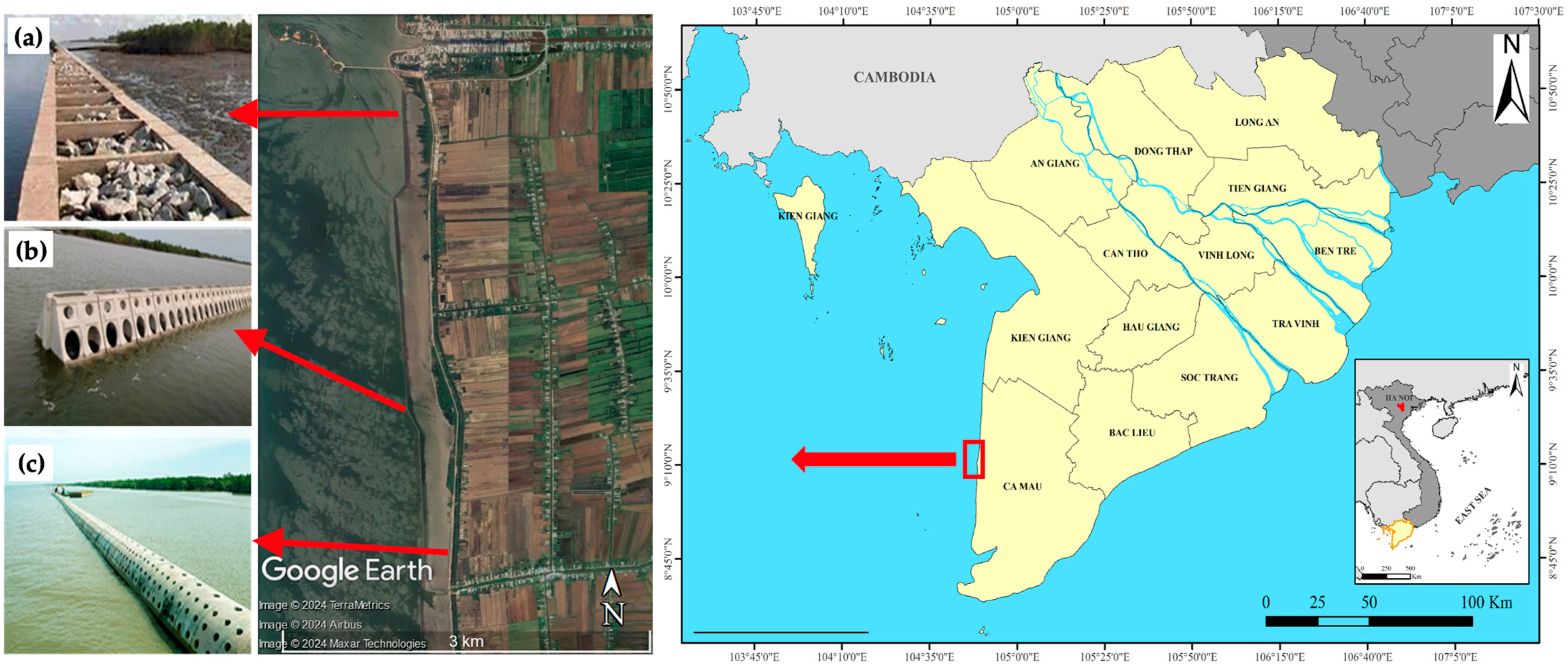
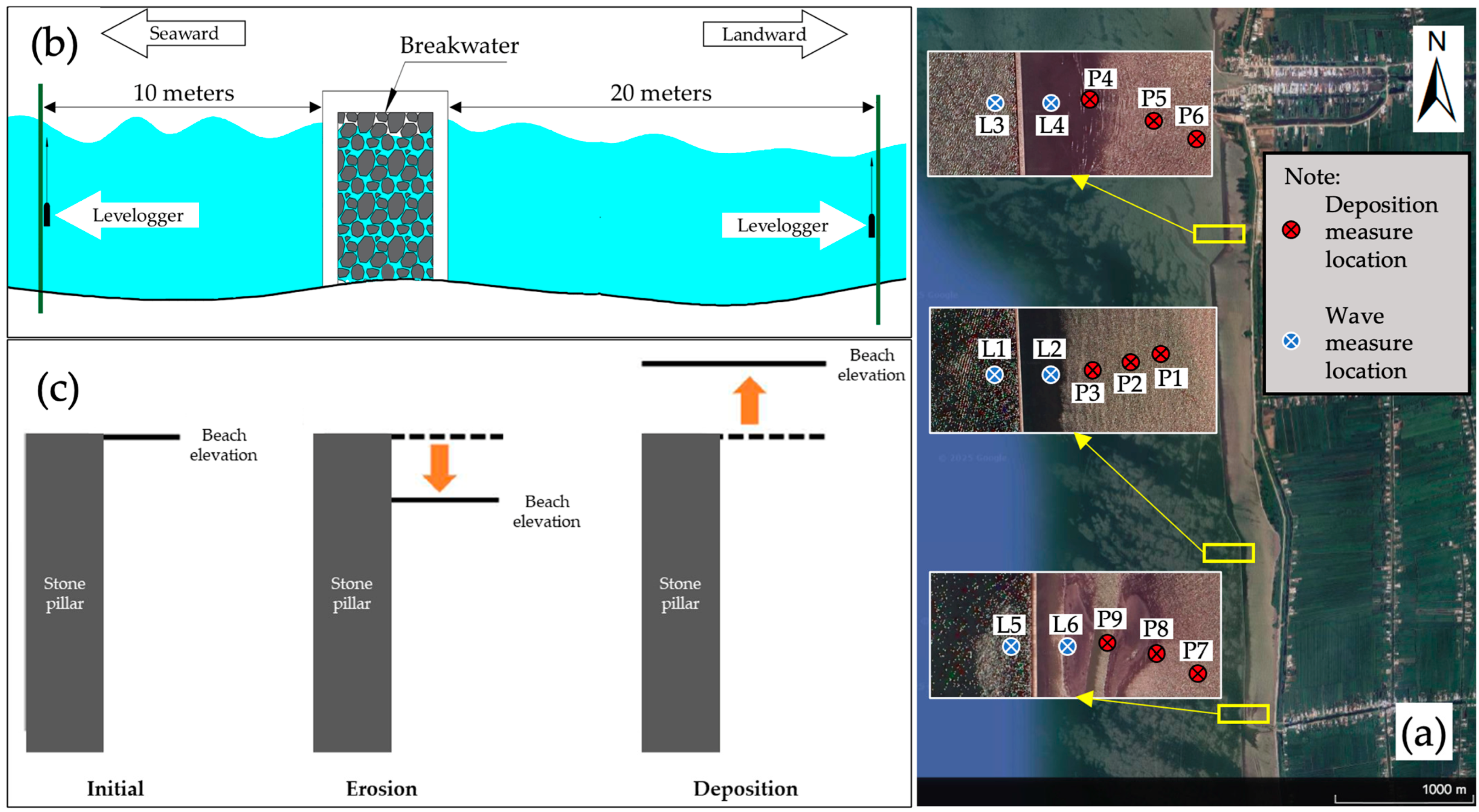
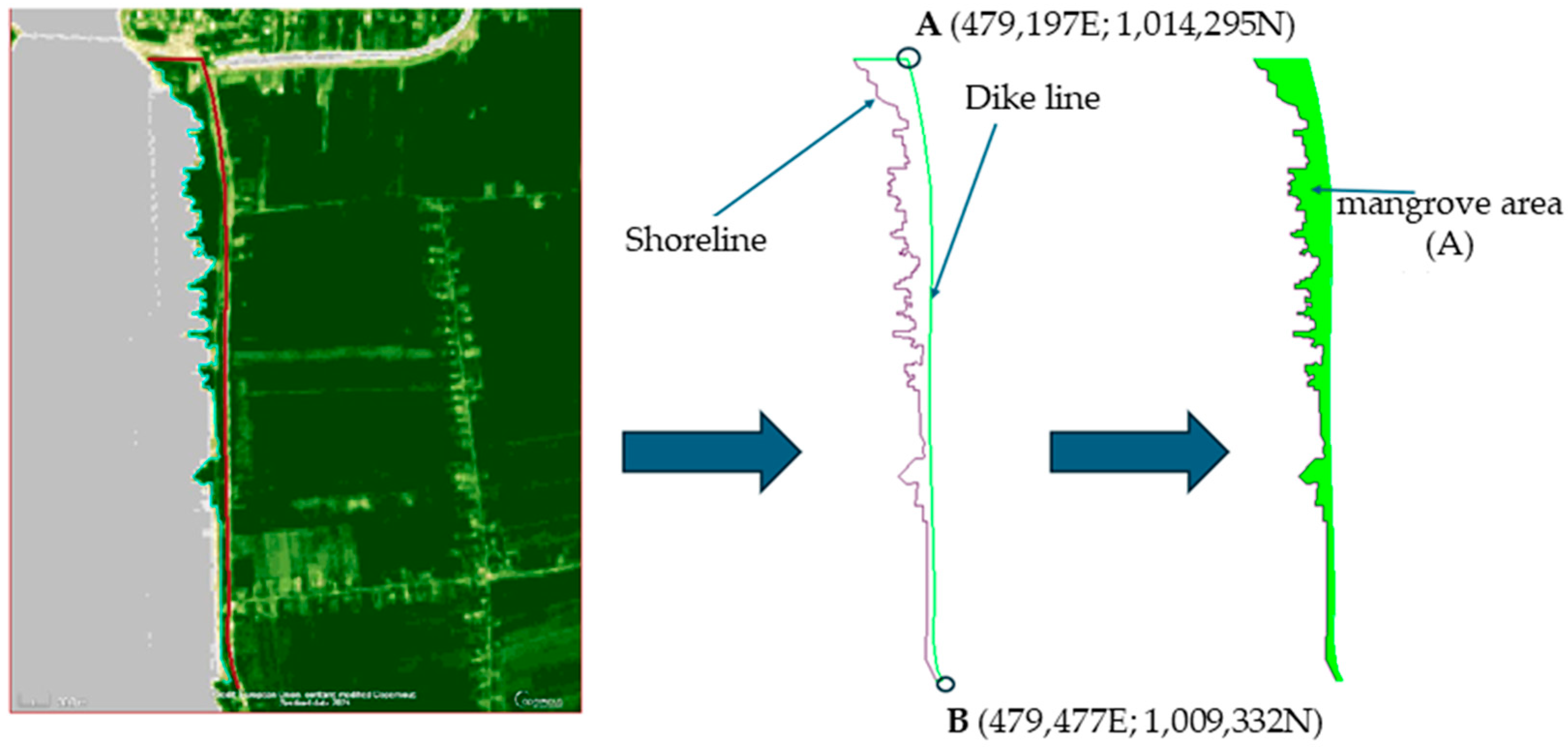


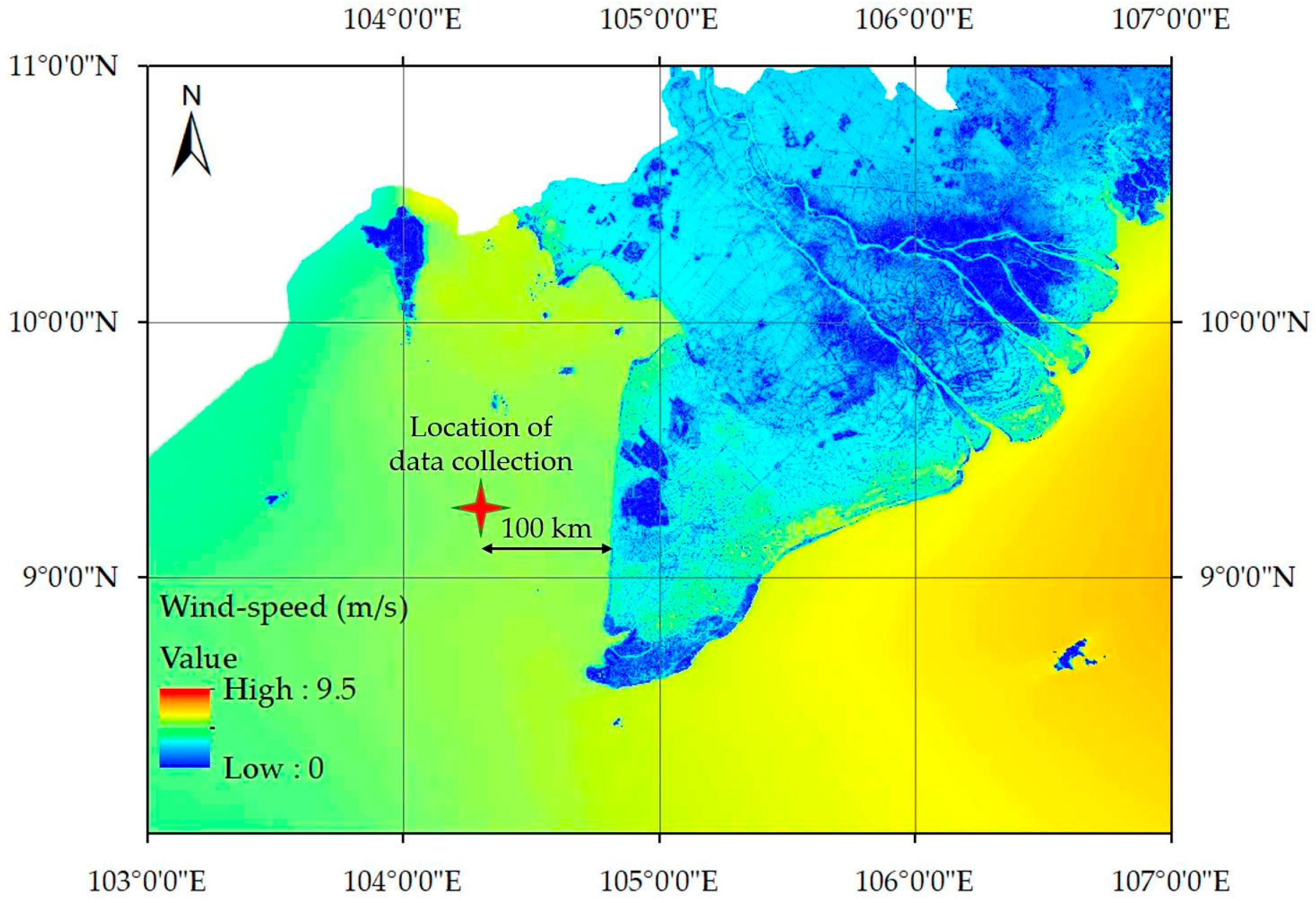
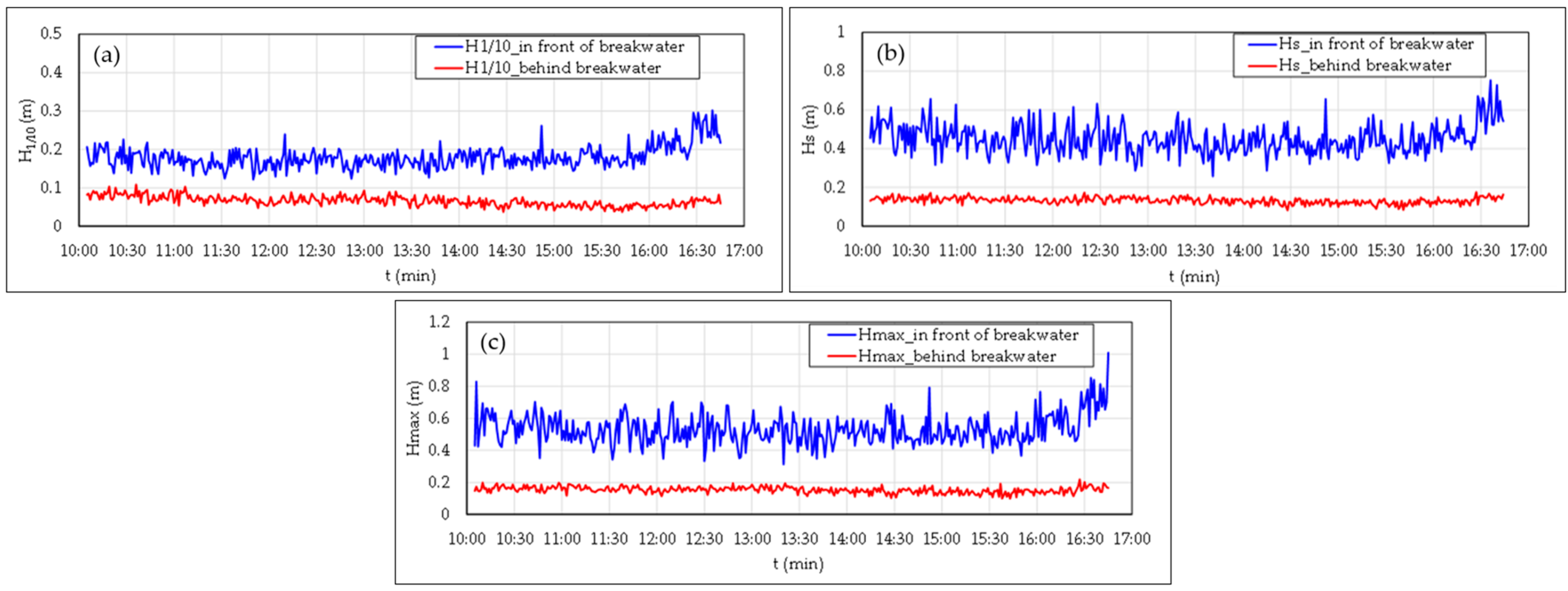
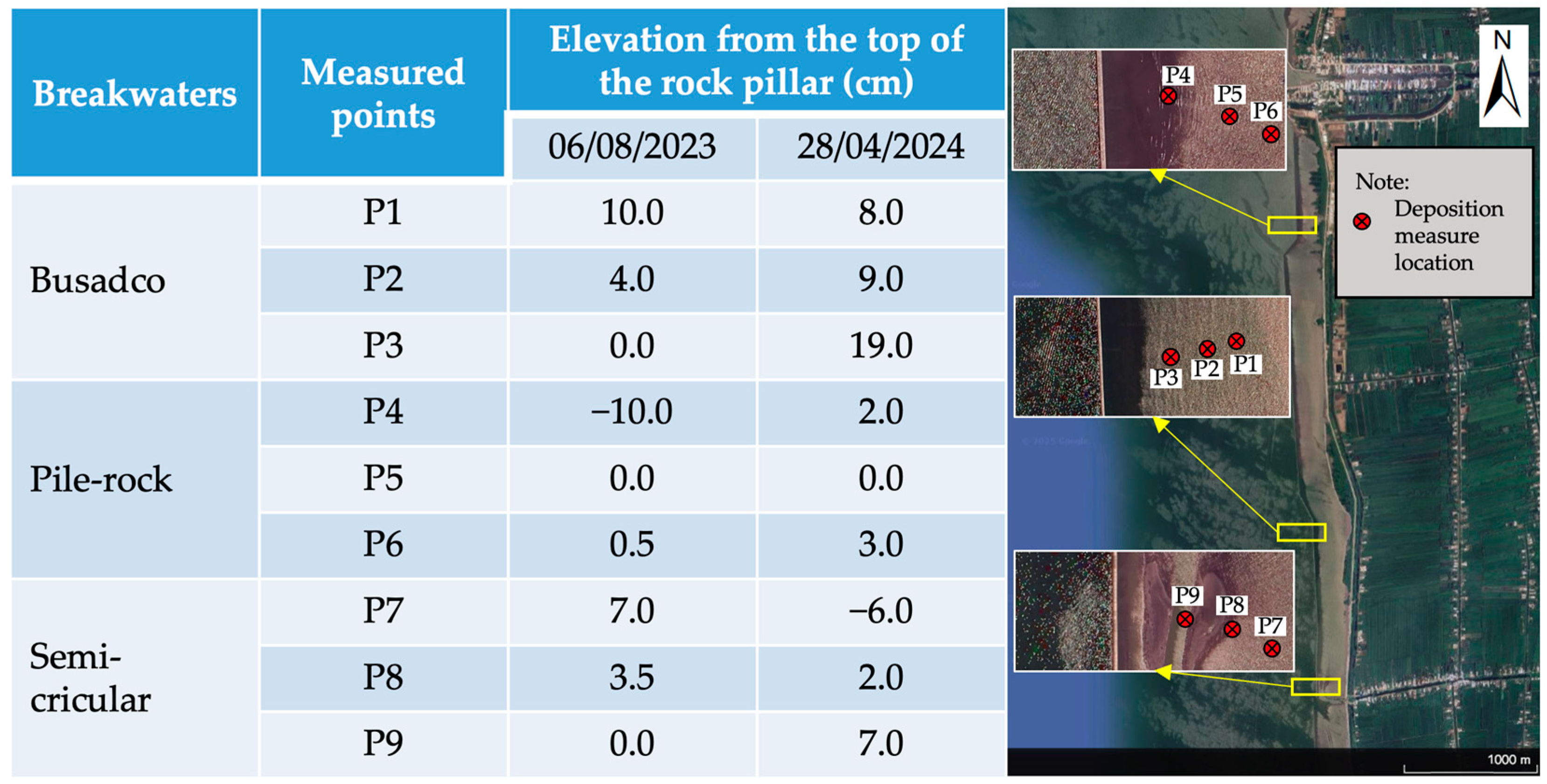
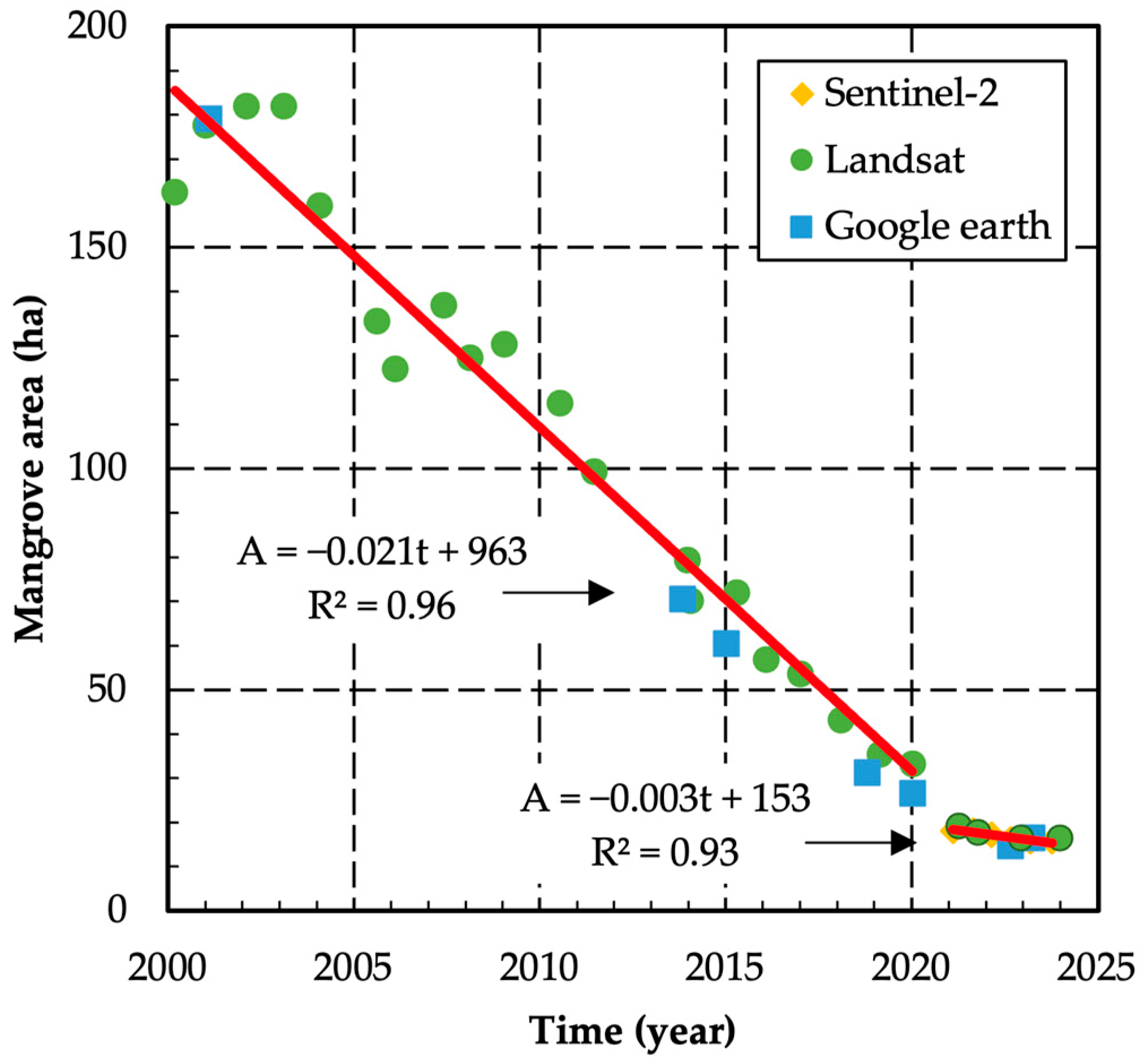
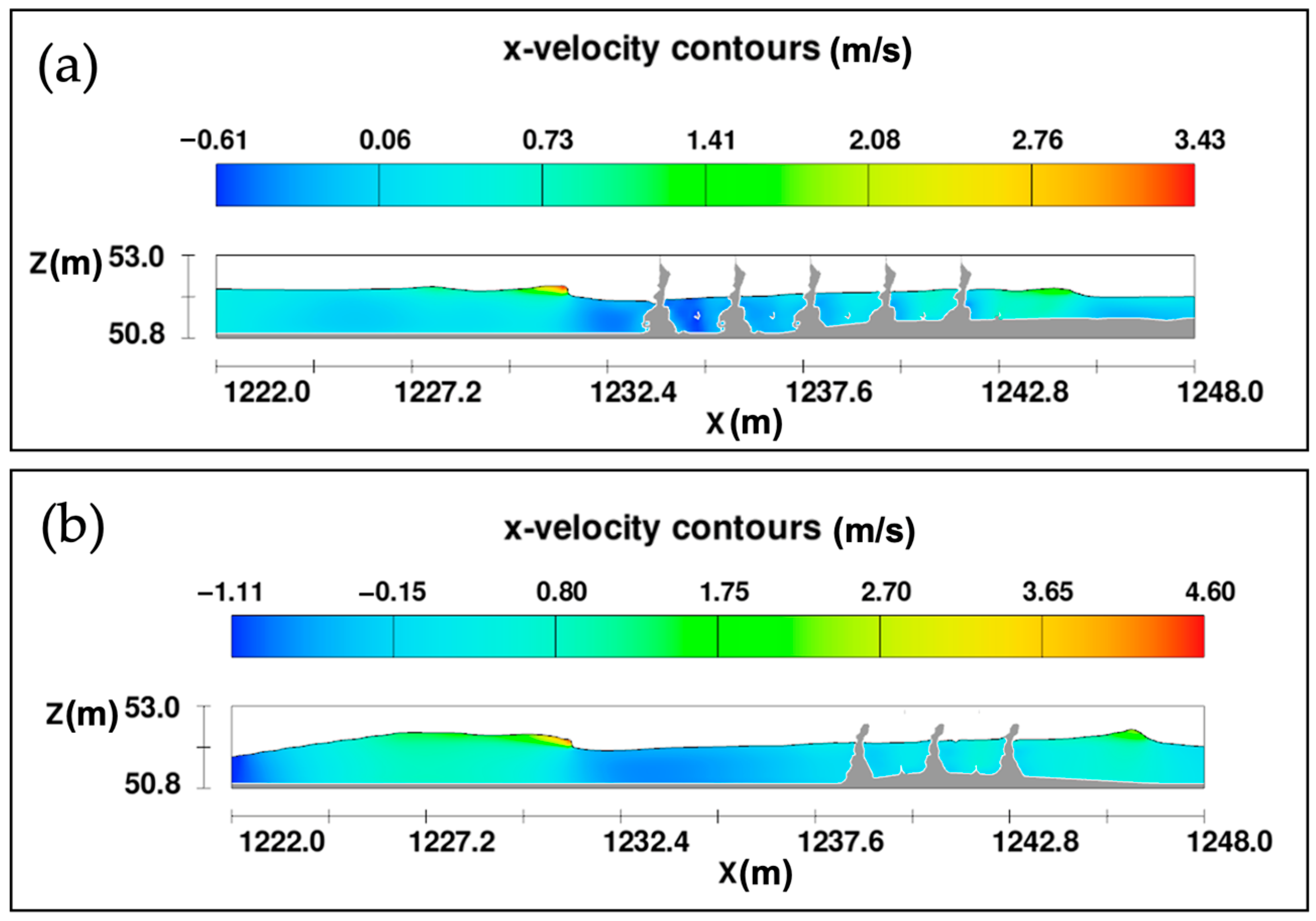
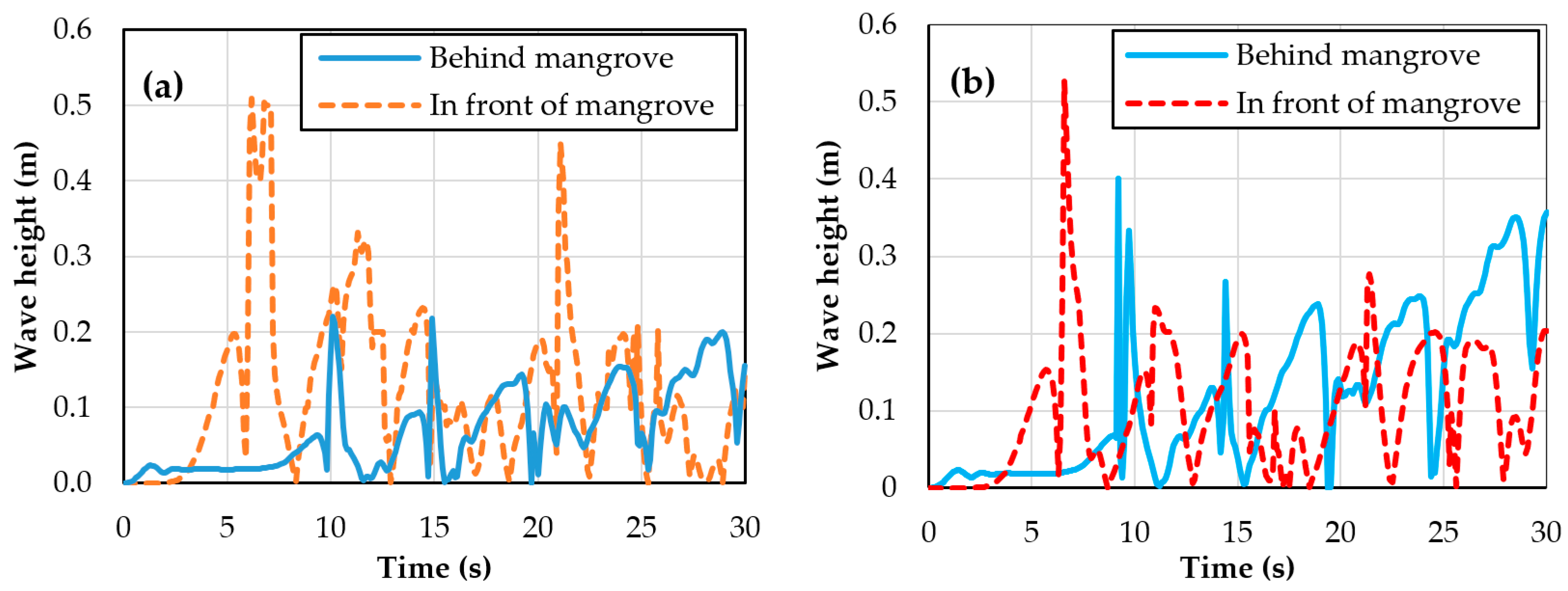

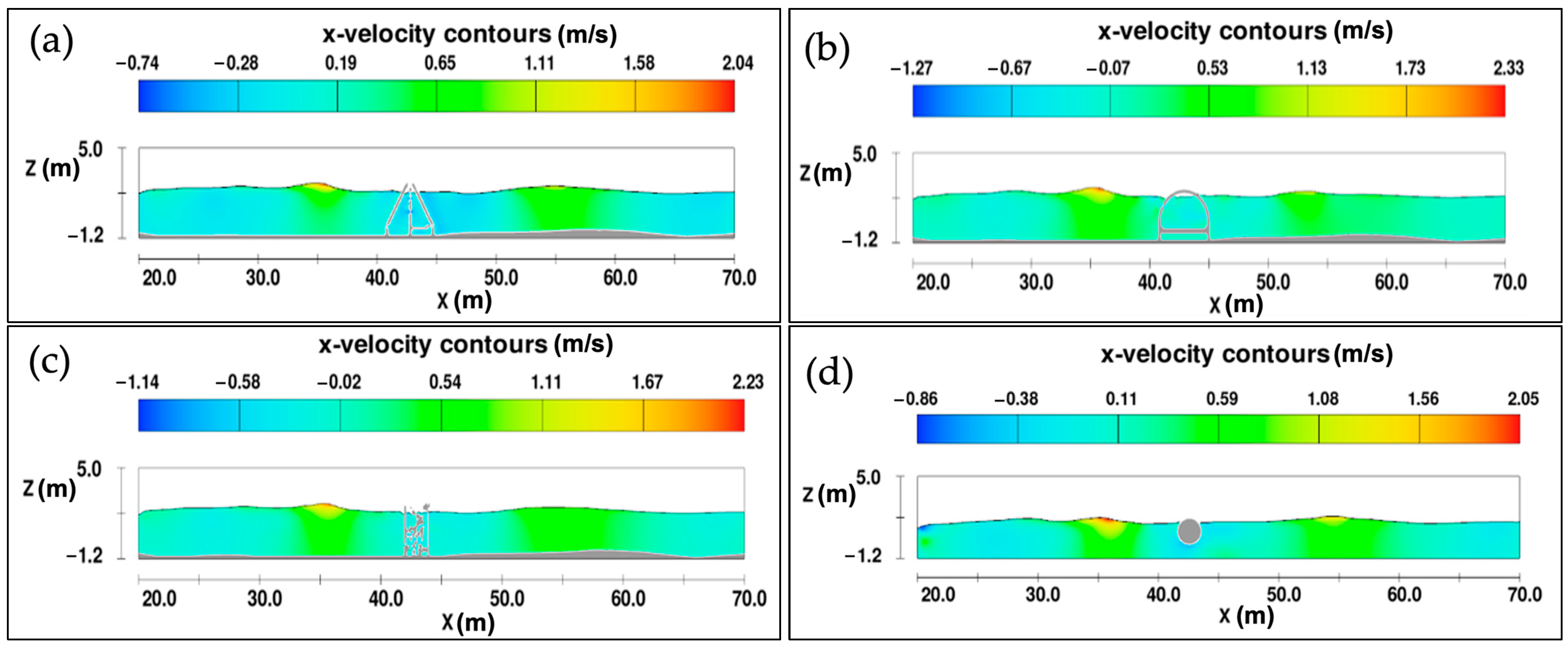
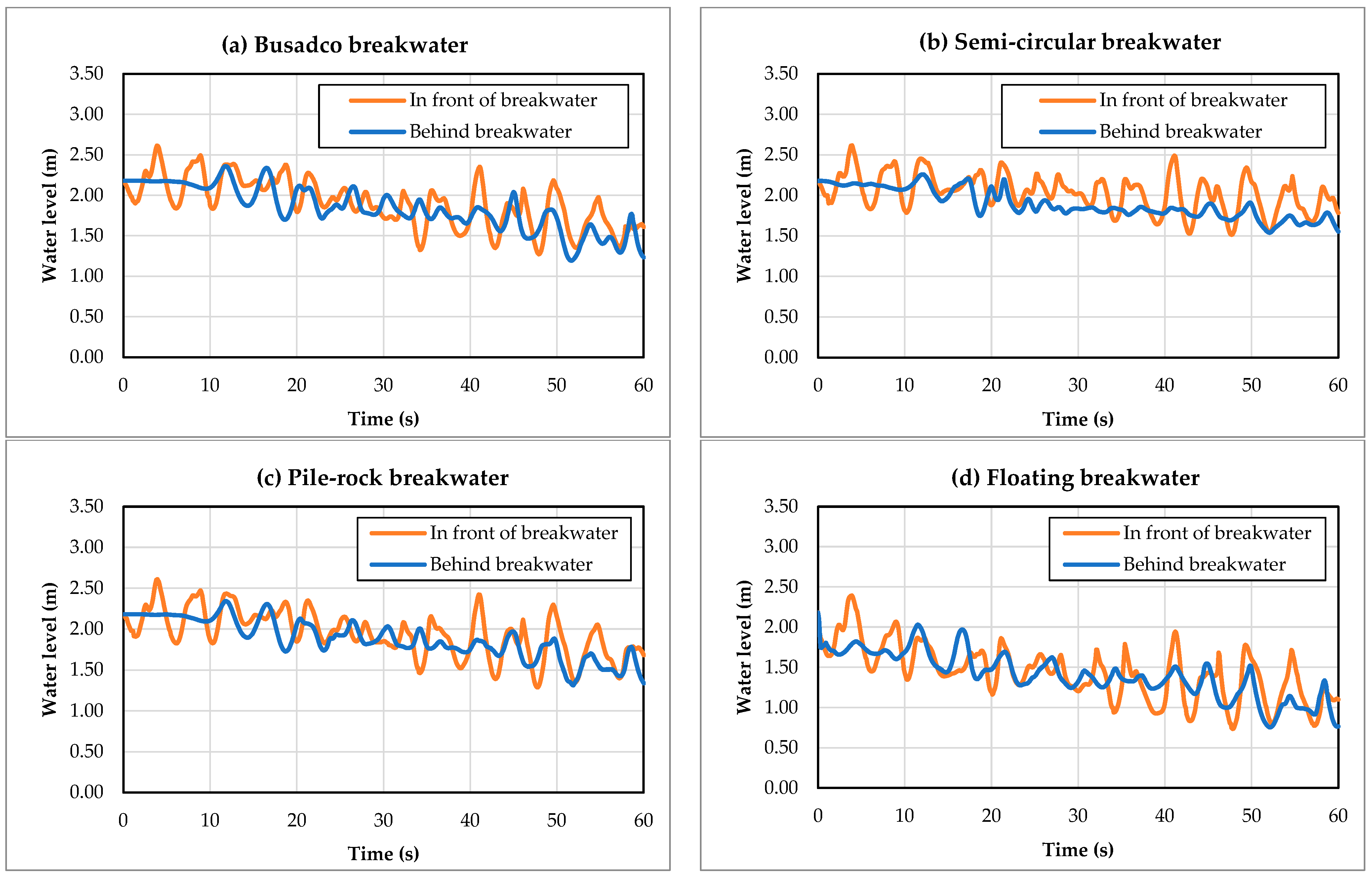

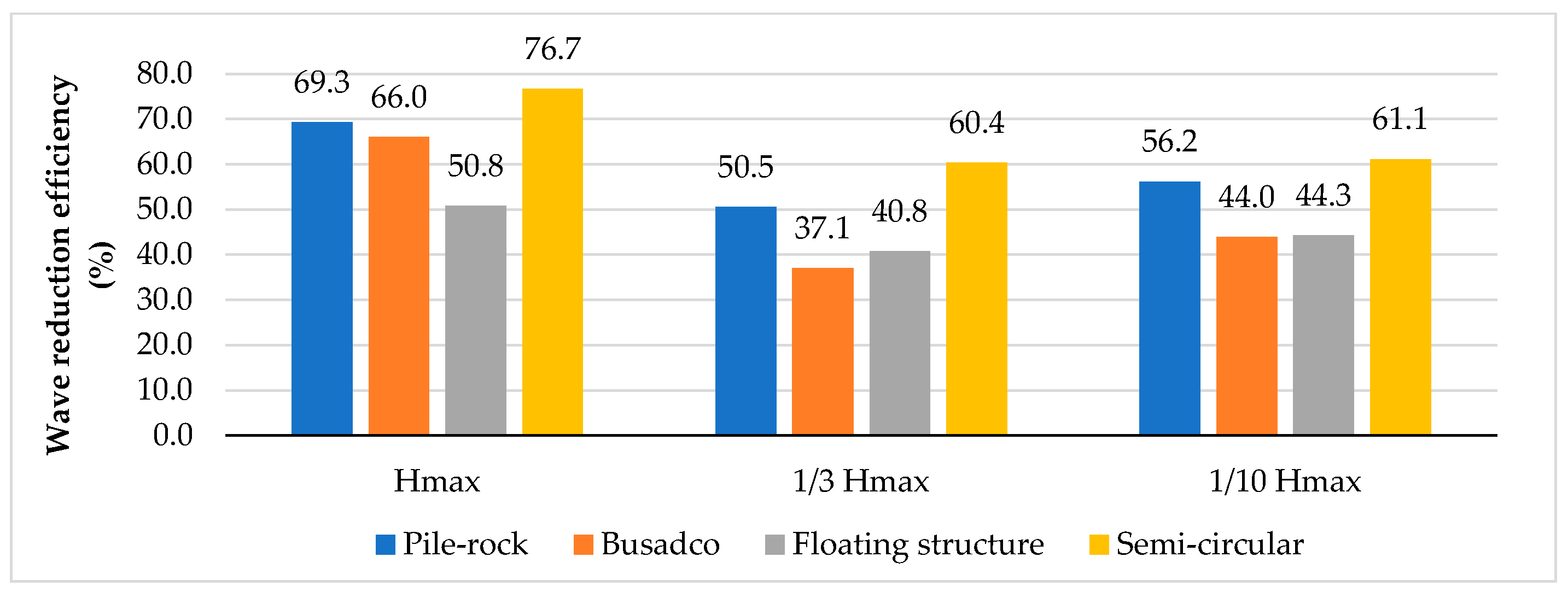
| No. | Date | Source | Sensor | Resolution (m × m/Pixel) | Coordinates |
|---|---|---|---|---|---|
| 1 | 10/03/2000 | Landsat 5 | TM | 30 | UTM |
| 2 | 08/01/2001 | Landsat 5 | TM | 30 | UTM |
| 3 | 07/02/2002 | Landsat 5 | TM | 30 | UTM |
| 4 | 07/02/2003 | Landsat 5 | TM | 30 | UTM |
| 5 | 02/02/2004 | Landsat 5 | TM | 30 | UTM |
| 6 | 15/08/2005 | Landsat 5 | TM | 30 | UTM |
| 7 | 07/02/2006 | Landsat 5 | TM | 30 | UTM |
| 8 | 02/06/2007 | Landsat 5 | TM | 30 | UTM |
| 9 | 13/02/2008 | Landsat 5 | TM | 30 | UTM |
| 10 | 14/01/2009 | Landsat 5 | TM | 30 | UTM |
| 11 | 28/07/2010 | Landsat 5 | TM | 30 | UTM |
| 12 | 29/06/2011 | Landsat 8 | OLI/TIRS | 30 | UTM |
| 13 | 27/12/2013 | Landsat 8 | OLI/TIRS | 30 | UTM |
| 14 | 28/01/2014 | Landsat 8 | OLI/TIRS | 30 | UTM |
| 15 | 21/04/2015 | Landsat 8 | OLI/TIRS | 30 | UTM |
| 16 | 19/02/2016 | Landsat 8 | OLI/TIRS | 30 | UTM |
| 17 | 20/01/2017 | Landsat 8 | OLI/TIRS | 30 | UTM |
| 18 | 12/02/2018 | Landsat 8 | OLI/TIRS | 30 | UTM |
| 19 | 27/02/2019 | Landsat 8 | OLI/TIRS | 30 | UTM |
| 20 | 13/01/2020 | Landsat 8 | OLI/TIRS | 30 | UTM |
| 21 | 14/10/2021 | Landsat 8 | OLI/TIRS | 30 | UTM |
| 22 | 20/12/2022 | Landsat 8 | OLI/TIRS | 30 | UTM |
| 23 | 31/12/2023 | Landsat 8 | OLI/TIRS | 30 | UTM |
| 24 | 03/02/2001 | Google Earth | - | 1 | UTM |
| 25 | 03/11/2013 | Google Earth | - | 1 | UTM |
| 26 | 13/01/2015 | Google Earth | - | 1 | UTM |
| 27 | 31/10/2018 | Google Earth | - | 1 | UTM |
| 28 | 23/01/2020 | Google Earth | - | 1 | UTM |
| 29 | 02/09/2022 | Google Earth | - | 1 | UTM |
| 30 | 04/04/2023 | Google Earth | - | 1 | UTM |
| 31 | 19/02/2021 | Sentinel-2 | MSI | 10 | UTM |
| 32 | 02/09/2021 | Sentinel-2 | MSI | 10 | UTM |
| 33 | 01/03/2022 | Sentinel-2 | MSI | 10 | UTM |
| 34 | 02/09/2022 | Sentinel-2 | MSI | 10 | UTM |
| 35 | 26/03/2023 | Sentinel-2 | MSI | 10 | UTM |
| 36 | 27/10/2023 | Sentinel-2 | MSI | 10 | UTM |
| Application Classification | Spectrum | Combination of Channels | |
|---|---|---|---|
| Landsat 5 | Landsat 8, 9 | ||
| Natural colors | RED, GREEN, BLUE | 3, 2, 1 | 4, 3, 2 |
| Vegetation (Infrared colors) | NIR, RED, GREEN | 4, 3, 2 | 5, 4, 3 |
| Agricultural land | SWIR-1, NIR, BLUE | 5, 4, 1 | 6, 5, 2 |
| Land/water | NIR, SWIR-1, RED | 4, 5, 3 | 5, 6, 4 |
| NDVI Value Range | Classification |
|---|---|
| –1.0~0.0 | Water, Clouds |
| 0.0~0.4 | Agricultural Land, Bare Soil, Urban Areas |
| 0.4~1.0 | Mangrove Forest |
| No. | Subject | Types of Elements | Manning Coefficient |
|---|---|---|---|
| 1 | Floating structure | Blocks | 0.011 |
| 2 | Mooring cables | Springs | - |
| 3 | Seabed | Blocks | 0.023 |
| No. | Parameter | Value |
|---|---|---|
| 1 | Model running time (s) | 60 |
| 2 | Fluid quantity | 1 |
| 3 | Fluid type | Incompressible fluid |
| 4 | Unit system | SI |
| 5 | Surface flow type | Free |
| 6 | Gravitational acceleration (m/s2) | 9.81 |
| 7 | Turbulent model | Large Eddy Simulation (LES) |
| No. | Parameter | Value |
|---|---|---|
| 1 | Gravity component (x, y, z) | (0, 0, −9.81) m/s2 |
| 2 | Smagorinsky coefficient (Large Eddy Simulation model) | 0.1 |
Disclaimer/Publisher’s Note: The statements, opinions and data contained in all publications are solely those of the individual author(s) and contributor(s) and not of MDPI and/or the editor(s). MDPI and/or the editor(s) disclaim responsibility for any injury to people or property resulting from any ideas, methods, instructions or products referred to in the content. |
© 2025 by the authors. Licensee MDPI, Basel, Switzerland. This article is an open access article distributed under the terms and conditions of the Creative Commons Attribution (CC BY) license (https://creativecommons.org/licenses/by/4.0/).
Share and Cite
Duy, D.V.; Ty, T.V.; Phat, L.T.; Minh, H.V.T.; Nam, N.D.G.; Downes, N.K.; Avtar, R.; Tanaka, H. Simulating the Coastal Protection Performance of Breakwaters in the Mekong Delta: Insights from the Western Coast of Ca Mau Province, Vietnam. J. Mar. Sci. Eng. 2025, 13, 1559. https://doi.org/10.3390/jmse13081559
Duy DV, Ty TV, Phat LT, Minh HVT, Nam NDG, Downes NK, Avtar R, Tanaka H. Simulating the Coastal Protection Performance of Breakwaters in the Mekong Delta: Insights from the Western Coast of Ca Mau Province, Vietnam. Journal of Marine Science and Engineering. 2025; 13(8):1559. https://doi.org/10.3390/jmse13081559
Chicago/Turabian StyleDuy, Dinh Van, Tran Van Ty, Lam Tan Phat, Huynh Vuong Thu Minh, Nguyen Dinh Giang Nam, Nigel K. Downes, Ram Avtar, and Hitoshi Tanaka. 2025. "Simulating the Coastal Protection Performance of Breakwaters in the Mekong Delta: Insights from the Western Coast of Ca Mau Province, Vietnam" Journal of Marine Science and Engineering 13, no. 8: 1559. https://doi.org/10.3390/jmse13081559
APA StyleDuy, D. V., Ty, T. V., Phat, L. T., Minh, H. V. T., Nam, N. D. G., Downes, N. K., Avtar, R., & Tanaka, H. (2025). Simulating the Coastal Protection Performance of Breakwaters in the Mekong Delta: Insights from the Western Coast of Ca Mau Province, Vietnam. Journal of Marine Science and Engineering, 13(8), 1559. https://doi.org/10.3390/jmse13081559












